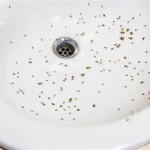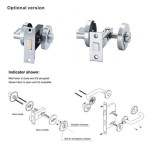French Bathroom Sink Aesthetics: A Blend of Elegance and Functionality
The French bathroom sink, often referred to as a "lavabo" in French, represents more than just a functional fixture; it is a design element that embodies a specific aesthetic. This aesthetic is characterized by a blend of elegance, functionality, and, sometimes, a touch of rustic charm. Understanding the nuances of French bathroom sink design requires an exploration of materials, styles, and the overall philosophy that informs their creation. The following sections will delve into the specifics of these facets.
Materials Commonly Used in French Bathroom Sinks
The selection of materials plays a pivotal role in defining the character of a French bathroom sink. Certain materials are preferred for their durability, aesthetic appeal, and ability to evoke a specific feeling. These choices frequently align with the overall design scheme of the bathroom, further enhancing its visual coherence.
Porcelain: Porcelain is a ubiquitous choice for bathroom sinks globally, including in French design. Its inherent qualities – non-porosity, resistance to staining, and ease of cleaning – make it a practical and hygienic option. French porcelain sinks often feature intricate detailing or subtle curves, adding a layer of sophistication beyond basic functionality. The smooth, glossy surface of porcelain also lends itself well to a variety of color options, from classic white to muted pastels, allowing for seamless integration into different bathroom designs.
Ceramic: Similar to porcelain, ceramic is another widely used material. While porcelain is a type of ceramic, it's generally fired at a higher temperature, making it denser and less porous. However, ceramic sinks offer a cost-effective alternative without sacrificing too much in terms of durability. French ceramic sinks might incorporate hand-painted designs or textured surfaces, showcasing traditional craftsmanship and adding a unique touch to the bathroom.
Stone: Natural stone, such as marble, granite, and travertine, imparts a sense of luxury and timelessness. These materials are prized for their unique veining patterns and natural variations, ensuring that each sink is a one-of-a-kind piece. Stone sinks are often treated with sealants to protect them from water damage and staining. While stone requires more maintenance than porcelain or ceramic, its beauty and durability make it a worthwhile investment for those seeking a high-end aesthetic. French bathrooms often incorporate stone sinks as a focal point, complemented by other natural materials like wood and linen.
Copper: Copper sinks, though less common than porcelain or stone, add a touch of rustic elegance and warmth to the French bathroom. Copper has natural antimicrobial properties, making it a hygienic choice for a sink. It develops a patina over time, adding to its character and charm. Copper sinks are often hammered or textured, further enhancing their visual appeal. They pair well with other rustic elements, such as exposed wood beams and wrought iron fixtures, creating a cozy and inviting atmosphere.
Enameled Cast Iron: Enameled cast iron combines the durability of cast iron with the smooth, protective layer of enamel. This material is resistant to chipping and scratching, making it a long-lasting option. Enameled cast iron sinks often feature a deep basin and a classic shape, reminiscent of vintage French designs. They are available in a range of colors, allowing for customization to suit different bathroom styles.
Different Styles of French Bathroom Sinks
French bathroom sink design encompasses a variety of styles, each reflecting different periods and influences. Understanding these styles helps in selecting a sink that complements the overall aesthetic of the bathroom and achieves the desired ambiance.
Pedestal Sinks: Pedestal sinks are a classic choice that embodies the elegance of French design. They consist of a sink basin supported by a tall, decorative pedestal. Pedestal sinks are ideal for smaller bathrooms, as they don't require a vanity cabinet, saving valuable floor space. French pedestal sinks often feature ornate detailing on the pedestal and a gracefully curved basin. They evoke a sense of timelessness and sophistication, making them a popular choice for traditional French-inspired bathrooms.
Wall-Mounted Sinks: Wall-mounted sinks, also known as floating sinks, offer a minimalist and contemporary aesthetic. They are attached directly to the wall, creating a sense of openness and spaciousness. French wall-mounted sinks often feature clean lines and a simple design, allowing the focus to remain on the quality of the materials. They are a practical choice for modern bathrooms or those with limited space. The exposed plumbing can be hidden with a decorative shroud or left visible for an industrial-chic look.
Vanity Sinks: Vanity sinks are integrated into a cabinet or countertop, providing storage space for toiletries and other bathroom essentials. French vanity sinks can range from simple and functional to ornate and luxurious. The vanity cabinet often features intricate carvings, decorative hardware, and a distressed finish, adding to the overall aesthetic. The sink basin can be either undermount, drop-in, or vessel style.
Vessel Sinks: Vessel sinks, also known as above-counter sinks, sit on top of the countertop like a decorative bowl. They add a sculptural element to the bathroom and can be a focal point of the design. French vessel sinks come in a variety of shapes, sizes, and materials, from porcelain and ceramic to stone and copper. They are often paired with a tall faucet to accommodate the height of the sink. Vessel sinks can be used in both traditional and modern bathrooms, adding a touch of elegance and sophistication.
Farmhouse Sinks: While traditionally associated with kitchens, farmhouse sinks are increasingly being used in bathrooms to create a rustic and charming aesthetic. Farmhouse sinks, also known as apron-front sinks, feature a large, exposed front that extends slightly beyond the countertop. French farmhouse sinks are typically made of porcelain or enameled cast iron and are often paired with a vintage-style faucet. They evoke a sense of warmth and comfort, making them a popular choice for country-style bathrooms.
Key Elements of French Bathroom Sink Design Philosophy
Beyond the specific materials and styles, there exists an underlying philosophy that guides French bathroom sink design. This philosophy emphasizes a balance between functionality and aesthetics, creating a space that is both practical and visually appealing. Several key elements contribute to this design philosophy.
Emphasis on Natural Light: French design generally prioritizes natural light, and bathroom design is no exception. The placement of the sink is often considered in relation to windows to maximize natural light. Mirrors are also strategically placed to reflect light and enhance the brightness of the space. The use of light-colored materials, such as white porcelain and light-toned stone, further contributes to the airy and open feel of the bathroom.
Incorporation of Organic Shapes: French design often incorporates organic shapes and curves, softening the overall look and adding a touch of femininity. This is reflected in the design of the sink basin, which may feature gentle curves and rounded edges. Even in more modern designs, there is often a subtle emphasis on organic forms, creating a sense of harmony and balance.
Attention to Detail: Attention to detail is a hallmark of French design. This is evident in the selection of hardware, the placement of accessories, and the overall craftsmanship of the sink. Faucets are often chosen for their elegant design and high-quality materials. Decorative elements, such as soap dishes and toothbrush holders, are carefully selected to complement the sink and the overall aesthetic of the bathroom.
Blending of Old and New: French design often blends old and new elements, creating a sense of history and character. This can be seen in the juxtaposition of a vintage-style sink with modern fixtures or the incorporation of antique accessories into a contemporary bathroom. The goal is to create a space that is both timeless and personal.
Focus on Comfort and Relaxation: More than just a functional space, the French bathroom is conceived as a sanctuary for relaxation and rejuvenation. The design prioritizes comfort and creates a calming atmosphere. Soft lighting, plush towels, and luxurious bath products all contribute to the overall sense of well-being. The sink is an integral part of this equation, designed to be both functional and aesthetically pleasing, enhancing the overall experience.

French Cottage Bathroom Vanity How To Get The Look Details Country

French Cottage Bathroom Vanity How To Get The Look Details Country

French Provincial Bathroom Vanities Been Looking For Vanity Custom

French Cottage Bathroom Vanity How To Get The Look Details Country

French Master Bathroom With Pedestal Sink And Gold Mirror

32inch Mia Vanity Country French Style Bathroom

French Provincial Bathroom Vanities Been Looking For

French Country Bathroom Sink Ideas And Inspiration Hunker

Black French Sink Vanity With Gilt Mirror Eclectic Bathroom

11 French Country Vanity Options What I M Getting For Our Remodel North Of Bleu
Related Posts







